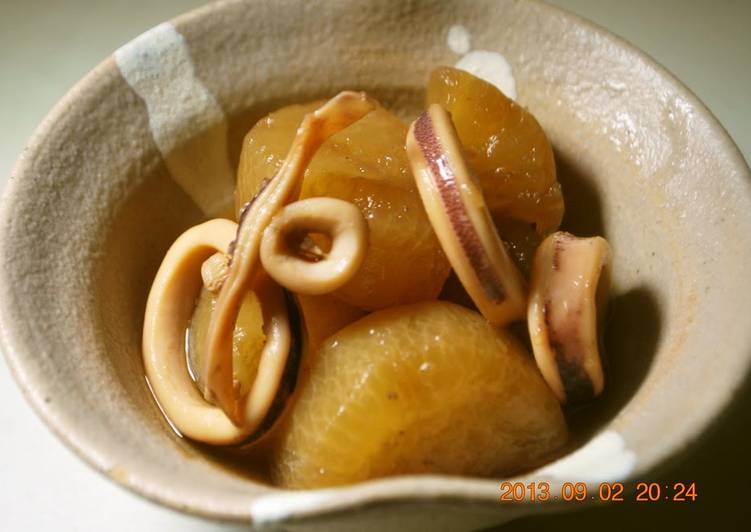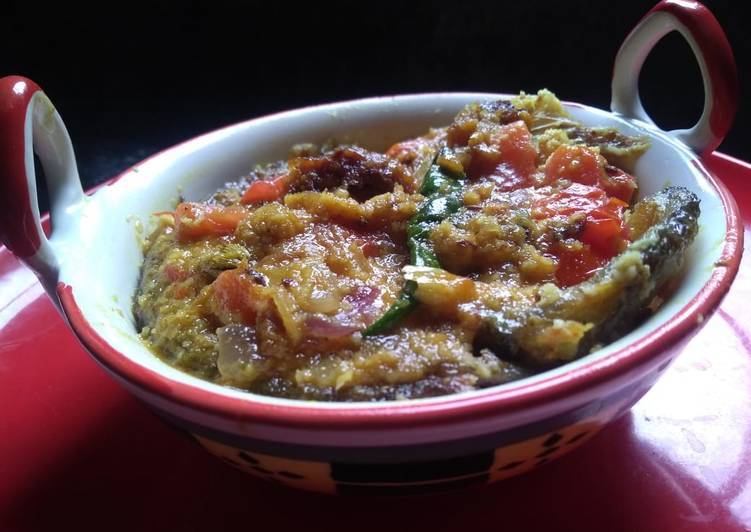
Hello everybody, I hope you’re having an incredible day today. Today, we’re going to prepare a distinctive dish, tender simmered daikon radish with squid. It is one of my favorites. For mine, I will make it a bit unique. This will be really delicious.
Japanese chef makes a Simmered pork and Daikon with sweet soy sauce. Braised daikon, or "daikon no nimono" is slowly simmered Japanese radish in a light dashi broth. Braised Japanese daikon radish, known simply in Japanese as "daikon no nimono" is a very common dish that If the daikon varies in thickness you'll find that some daikon are more tender than others. peel the daikon radish and cut it into large peaces. remove the guts from the squid.
Tender Simmered Daikon Radish with Squid is one of the most favored of recent trending meals on earth. It’s simple, it is quick, it tastes yummy. It is enjoyed by millions daily. They’re nice and they look fantastic. Tender Simmered Daikon Radish with Squid is something that I’ve loved my entire life.
To get started with this particular recipe, we must first prepare a few components. You can have tender simmered daikon radish with squid using 9 ingredients and 7 steps. Here is how you can achieve it.
The ingredients needed to make Tender Simmered Daikon Radish with Squid:
- Make ready 350 grams Daikon radish
- Take 1 whole squid Squid
- Get 300 ml Water
- Make ready 1/2 tsp Dashi stock granules
- Make ready 1 tbsp Sugar (light brown sugar)
- Prepare 1 tbsp Sake
- Take 2 tbsp Soy sauce
- Make ready 1 tbsp Mirin
- Get 1 *Thinly sliced ginger (optional)
Pork Banh Mi Sandwiches, Chef Jj Johnson's Pork Suya With Kimchi, Bahn Mi. Slow-simmering the slices of daikon—that's Japanese radish—in a soy and mirin-based broth allows the sweet and savory flavors to soak right into the The result is tender hunks of radish with a slight crunch and a deep, rich flavor. Once the daikon is cooked, you can use the same simmering liquid to. There's nothing quite like eating simmered daikon radish.
Steps to make Tender Simmered Daikon Radish with Squid:
- Cut the daikon radish into 2 cm thick round, then cut in half or quarters. You can round the edges if you prefer.
- In a pan, add a little salt (not listed) and water, and boil the daikon radish. Add the daikon radish before boiling. It should be cooked and translucent in about 20 minutes. It is better to boil in the water leftover from rinsing rice.
- This prep is very important for the taste to penetrate into the daikon radish. While the daikon radish is boiling, prepare the squid by removing the guts and the cartilage, then cut into appropriately sized pieces.
- Add water, dashi stock granules, squid, sugar and sake into the pan from Step 2. Skim off the scum until it comes to a boil, about 5 minutes.
- Add soy sauce and mirin and put on a small lid or a piece of aluminium foil that sits right on top of it, and simmer over low heat for 15-20 minutes. The flavors of the simmering broth here will soak into the daikon radish as it all cools down.
- Calculate the cooking time including the cooling time, before cooking. You would like to cool it for at least 30 minutes. Flip the daikon radish over around halfway through cooling.
- Warm it up before serving and enjoy. You can add and simmer the tentacles with it, deep fry, or toss into a salad.
It's soft and juicy and carries with it all the flavor you could ever want. Today, we're pairing that little magic root with yellowtail and simmering them together. To save some time, we'll be using something. A simple braised white radish (daikon) becomes a surprisingly tasty dish when cooked in a thick soy flavoured sauce with pork mince (ground pork). The daikon is cooked until it becomes semi-transparent and tender.
So that is going to wrap this up with this exceptional food tender simmered daikon radish with squid recipe. Thanks so much for your time. I’m confident that you can make this at home. There is gonna be more interesting food in home recipes coming up. Don’t forget to bookmark this page in your browser, and share it to your family, colleague and friends. Thank you for reading. Go on get cooking!

